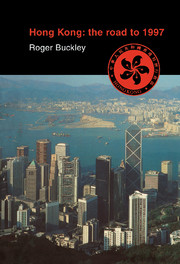Book contents
- Frontmatter
- Contents
- Preface
- Acknowledgements
- Glossary
- Map: Hong Kong, 1997
- Introduction: prewar colony
- 1 Reoccupation: postwar comeback, 1945–7
- 2 Consolidation: the Grantham years, 1947–58
- 3 Growth: the 1960s
- 4 Transformation: the MacLehose years, 1971–82
- 5 Negotiations: Sino-British diplomacy, 1982–92
- 6 Confrontation: the Patten years, 1992–5
- 7 Future: to 1997 and beyond
- 8 Conclusions: endgame
- Appendixes
- Bibliography
- Index
1 - Reoccupation: postwar comeback, 1945–7
Published online by Cambridge University Press: 20 November 2009
- Frontmatter
- Contents
- Preface
- Acknowledgements
- Glossary
- Map: Hong Kong, 1997
- Introduction: prewar colony
- 1 Reoccupation: postwar comeback, 1945–7
- 2 Consolidation: the Grantham years, 1947–58
- 3 Growth: the 1960s
- 4 Transformation: the MacLehose years, 1971–82
- 5 Negotiations: Sino-British diplomacy, 1982–92
- 6 Confrontation: the Patten years, 1992–5
- 7 Future: to 1997 and beyond
- 8 Conclusions: endgame
- Appendixes
- Bibliography
- Index
Summary
[The p]opulation in general seems glad to see us back and [a] harbour filled with British warships gives obvious pleasure but we must bring much more than ability to maintain order if our welcome is to endure. Difficult times lie ahead. (Rear-Admiral Cecil Harcourt to Chiefs of Staff, 18 September 1945)
in these democratic days it is an essential function of the ruler to educate the ruled to a sense of their civic duties. (Sir Robert Kotewall to Brigadier MacDougall, Hong Kong, 25 April 1946)
There was nothing very glorious about the British reoccupation of Hong Kong in August 1945. It was the product of both quick thinking and good fortune as action took place simultaneously on domestic and Allied fronts in the scramble for succession to defeated Imperial Japan. The internal situation was the result of prompt action by Colonial Secretary Franklin Gimson and a small number of British internees in asserting control over the territory once news of the Japanese surrender had percolated through to the beleaguered camps. The international situation, however, was still highly confused when British naval units arrived off Hong Kong to support Gimson's claims, while diplomats in Washington, London and Chungking continued to fight their battles over who should be permitted control of the disputed territory.
To back up Gimson's bid to be in charge of Hong Kong it was vital that sufficient British military force be on hand as quickly as possible.
- Type
- Chapter
- Information
- Hong Kong: The Road to 1997 , pp. 18 - 30Publisher: Cambridge University PressPrint publication year: 1997



